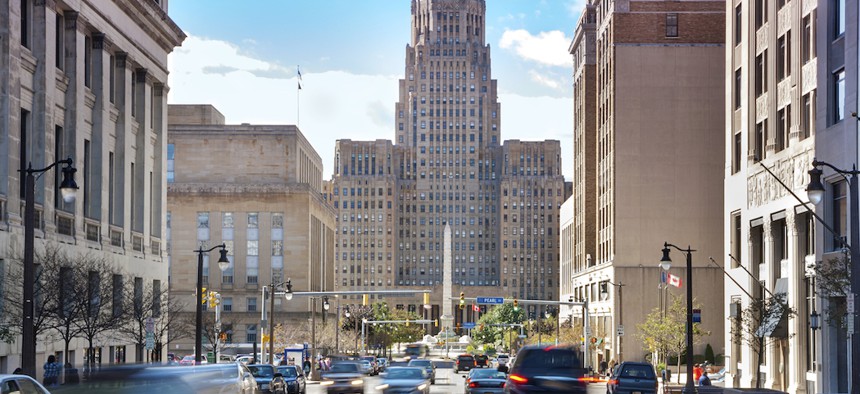New York may still be months away from a return to some semblance of normal. But as the state starts to get a handle on the evolving crisis, New Yorkers are getting little tastes of the before times. In New York City, alternate side parking has returned after being suspended for two months – there may be a pandemic raging, but that’s no excuse for litter-strewn streets. And Gov. Andrew Cuomo announced that small religious services of up to 10 people can resume. We New Yorkers can have a little normalcy, as a treat. Keep reading for the rest of the week’s not-so-normal news.
The shifting reopening metrics
Gov. Andrew Cuomo announced that two more upstate areas can enter the first phase of reopening: Western New York and the Capital Region. However, those reopenings were only possible because of the amended criteria that Cuomo established for deaths and new hospitalizations. A region can reopen if it has a 14-day sustained decline in total net hospitalizations and deaths based on three-day rolling averages. Originally, alternative metrics also allowed a region to reopen if it never had more than 15 new hospitalizations or more than 5 deaths based on three-day averages since the beginning of the outbreak. That language still exists on the governor’s website explaining the reopening metrics. However, Cuomo announced a change to the alternative metrics. Rather than measuring from the start of the pandemic, the state now measures from May 15, the first day other parts of the state began reopening. Western New York, for example, should have been a least a week away from reopening when it did, but thanks to the new metrics, Cuomo announced it entered the first phase on May 19. The Capital Region was in a similar boat. Because the area didn’t see immediate spikes in hospitalizations or deaths after May 15, it was permitted to reopen after recruiting enough contact tracers.
New York’s beach boondoggle
New York City residents hoping to hit the beach for Memorial Day weekend had their hopes squashed by Mayor Bill de Blasio and Long Island officials. After de Blasio announced city beaches would be closed to swimming, officials on Long Island floated the possibility of restricting the island’s beaches to residents of Nassau and Suffolk counties to prevent overcrowding from city interlopers. Initially, de Blasio said that city residents should be allowed on Long Island beaches, adding that there should not be “any ill feeling toward someone depending on where they come from.” Nassau County Executive Laura Curran said she spoke with the mayor and understood his rationale, suggesting a compromise was in the works. But soon after, she announced she would sign legislation restricting access to Nickerson Beach to county residents only. Suffolk County Executive Steve Bellone had announced earlier his intention to do the same for his county’s beaches.
Cuomo defends nursing home policies
Amid growing scrutiny over the state’s policy of sending recovering coronavirus patients to nursing homes, Cuomo continued to defend his administration’s actions. Responding to criticisms of his March 25 directive, Cuomo placed the blame on President Donald Trump’s administration, saying he was just following federal guidelines. He earlier said the state didn’t do anything wrong, and the high number of deaths – nearing 6,000 at nursing homes in New York – is at least partly attributable to bad luck. The state Department of Health did not change its rules for nursing homes until earlier this month, stating that homes could not accept any residents who had tested positive. The March 25 order has been removed from the Department of Health website, according to The New York Times.
Democratic incumbents kicked off the ballot
Two Democratic assemblywomen will no longer appear on the June primary ballot after the state’s top court ruled that petitioning errors made them ineligible. Three-term Assemblywoman Rebecca Seawright was kicked off the ballot because she failed to include a cover letter when she filed her paperwork. Although a mid-level court decided to keep her on the ballot, offering Seawright a glimmer of hope, the state Court of Appeals reversed that decision. The Court of Appeals also removed Assemblywoman Carmen Arroyo for a slightly more insidious reason. The 26-year incumbent had backdated a large number of petitions, which amounted to fraud. The decision opens the door to her insurgent primary opponent Amanda Septimo, who is backed by the Working Families Party.
Racial and economic disparities in COVID-19 deaths
New data released by New York City painted in sharp contrast the racial and economic disparities in coronavirus deaths. Low-income communities that are largely black and Latino have borne the brunt of the harm from the pandemic. The Brooklyn communities of Starrett City and East New York had the highest death rates, while the Bronx was the hardest-hit borough overall. Most of the areas with the lowest death rates were in wealthy Manhattan neighborhoods with mostly white residents.
NEXT STORY: The carpetbaggers in the 2020 primaries


